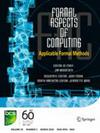基于精化的铁路网络物理信号系统形式化开发
IF 1.4
4区 计算机科学
Q3 COMPUTER SCIENCE, SOFTWARE ENGINEERING
引用次数: 1
摘要
多年来,形式化方法已成功应用于铁路领域,以正式证明铁路系统的安全性。尽管如此,在解决现代铁路信号系统的网络物理性质的正式方法领域,几乎没有做什么。在本文中,我们提出了一种正式开发网络物理铁路信号系统的方法,该方法基于基于精化的建模和基于证明的验证。我们的方法利用Event-B形式化规范语言以及混合系统和通信建模模式来开发通用的混合铁路信号系统模型,该模型可以进一步细化以捕获特定的铁路信号系统。本文的主要技术贡献是改进了与其他铁路信号子系统的混合列车Event-B模型。正式证明了网络物理铁路信号系统的完整模型,以确保机车车辆安全分离并防止脱轨。此外,本文还展示了基于精化的网络物理系统开发方法的优势,该方法能够分解问题,从而减少验证和建模工作。本文章由计算机程序翻译,如有差异,请以英文原文为准。
A Refinement-based Formal Development of Cyber-physical Railway Signalling Systems
For years, formal methods have been successfully applied in the railway domain to formally demonstrate safety of railway systems. Despite that, little has been done in the field of formal methods to address the cyber-physical nature of modern railway signalling systems. In this article, we present an approach for a formal development of cyber-physical railway signalling systems that is based on a refinement-based modelling and proof-based verification. Our approach utilises the Event-B formal specification language together with a hybrid system and communication modelling patterns to developing a generic hybrid railway signalling system model that can be further refined to capture a specific railway signalling system. The main technical contribution of this article is the refinement of the hybrid train Event-B model with other railway signalling sub-systems. The complete model of the cyber-physical railway signalling system was formally proved to ensure a safe rolling stock separation and prevent their derailment. Furthermore, the article demonstrates the advantage of the refinement-based development approach of cyber-physical systems, which enables a problem decomposition and in turn reduction in the verification and modelling effort.
求助全文
通过发布文献求助,成功后即可免费获取论文全文。
去求助
来源期刊

Formal Aspects of Computing
工程技术-计算机:软件工程
CiteScore
3.30
自引率
0.00%
发文量
17
审稿时长
>12 weeks
期刊介绍:
This journal aims to publish contributions at the junction of theory and practice. The objective is to disseminate applicable research. Thus new theoretical contributions are welcome where they are motivated by potential application; applications of existing formalisms are of interest if they show something novel about the approach or application.
In particular, the scope of Formal Aspects of Computing includes:
well-founded notations for the description of systems;
verifiable design methods;
elucidation of fundamental computational concepts;
approaches to fault-tolerant design;
theorem-proving support;
state-exploration tools;
formal underpinning of widely used notations and methods;
formal approaches to requirements analysis.
 求助内容:
求助内容: 应助结果提醒方式:
应助结果提醒方式:


